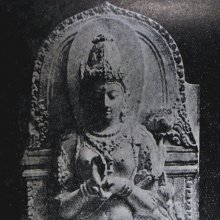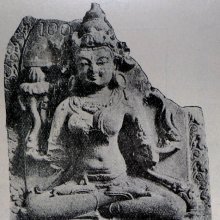Kanakaprajnaparamita, Kanakaprajñāpāramitā, Kanaka-prajnaparamita: 1 definition
Introduction:
Kanakaprajnaparamita means something in Buddhism, Pali. If you want to know the exact meaning, history, etymology or English translation of this term then check out the descriptions on this page. Add your comment or reference to a book if you want to contribute to this summary article.
Images (photo gallery)
In Buddhism
Tibetan Buddhism (Vajrayana or tantric Buddhism)
Source: archive.org: The Indian Buddhist IconographyKanakaprajñāpāramitā (कनकप्रज्ञापारमिता) refers to a variety of Prajñāpāramitā: one of the female emanations of Akṣobhya, as mentioned in the 5th-century Sādhanamālā (a collection of sādhana texts that contain detailed instructions for rituals).—Her Colour is Golden; her Mudrā is the dharmacakra; her Āsana is the vajraparyaṅka; her Symbol is the book on lotus on two sides.—Prajñāpāramitā is the embodiment of the Mahāyāna Scripture of the same name which was, according to the Buddhist tradition, restored from the nether regions by Nāgārjuna in the second century A. D. Buddha is said to have entrusted this Book of Transcedental Knowledge to the care of the Nāgas in the nether regions, as in his time people were not sufficiently intelligent to grasp the true meaning of the doctrines it contained.
The Dhyāna (meditation instructions) of Kanakaprajñāpāramitā described in the Sādhanamālā as follows:—
[This form of Prajñāpāramitā is identical in all respects with one of the forms described previously [i.e., Sitaprajñāpāramitā and Kanakaprajñāpāramitā]. The difference lies in the fact that although she exhibits the dharmacakra-mudrā with her two hands, there are two books on two lotuses rising from under her two arm-pits. She is golden in colour.]

Tibetan Buddhism includes schools such as Nyingma, Kadampa, Kagyu and Gelug. Their primary canon of literature is divided in two broad categories: The Kangyur, which consists of Buddha’s words, and the Tengyur, which includes commentaries from various sources. Esotericism and tantra techniques (vajrayāna) are collected indepently.
See also (Relevant definitions)
Partial matches: Kanaka, Prajnaparamita.
Full-text: Prajnaparamita.
Relevant text
Search found 1 books and stories containing Kanakaprajnaparamita, Kanakaprajñāpāramitā, Kanaka-prajnaparamita, Kanaka-prajñāpāramitā; (plurals include: Kanakaprajnaparamitas, Kanakaprajñāpāramitās, prajnaparamitas, prajñāpāramitās). You can also click to the full overview containing English textual excerpts. Below are direct links for the most relevant articles:
The Indian Buddhist Iconography (by Benoytosh Bhattachacharyya)

